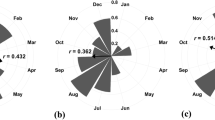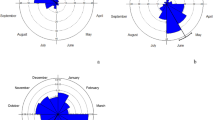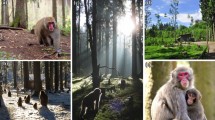Abstract
We gathered data over a 3-year period (1988–1990) on two free-ranging, island populations of rhesus macaques (Macaca mulatta)to test hypotheses concerning birth seasonal asynchrony and the relationship between climate and reproductive seasonality. Rhesus macaques from Kashmir, India, were translocated to Key Lois in 1973 and from Key Lois to Raccoon Key in 1978. Both sites are low-lying mangrove islands in the Florida Keys. Floral diversity and abundance are greater on Raccoon Key than on Key Lois. Average maximal and minimal temperatures per month did not vary significantly between Raccoon Key and Key Lois over the 3-year period. Average minimal temperatures per month on Key Lois, but not Raccoon Key, varied significantly between years. There were no significant variations in either the amount or the dates of rainfall over the 3-year period for the study area. A combined total of 1524 births was recorded for Raccoon Key (N = 879) and Key Lois (N =645). The birth season on Raccoon Key began 6 weeks earlier than on Key Lois. Births were associated with warmer, rainier months on both islands. Conceptions were associated with cooler, drier months at both study sites. No significant correlations were found between the date of the onset of the summer rains and either median conception or median birth dates on Raccoon Key or Key Lois. Our results do not substantiate the hypothesis that the onset of rainfall, within the temporal period set by photoperiod, regulates seasonal reproduction in rhesus macaques. We suggest that reproductive seasonality in the study populations may be influenced by a variety of factors.
Similar content being viewed by others
References
Altmann, J. (1980).Baboon Mothers and Infants, Harvard University Press, Cambridge, Mass.
Barsotti, D. A., Abrahamson, L. J., Marlar, R. J., and Allen, R. J. (1980). Effects of climate controlled housing on reproductive potential of rhesus monkeys.J. Reprod. Fertil. 59: 15–20.
Birkner, F. E. (1970). Photic influences on primate (Macaca mulatto) reproduction.Lab. Anim. Care 20: 181–185.
Buss, D. H. (1968). Gross composition and variation of the components of baboon milk during natural lactation.J. Nutr. 96: 421–426.
Drickamer, L. C. (1974). A ten-year summary of reproductive data for free-rangingMacaca mulatto.Folia Primatol 21: 61–80.
Foster, H. L. (1975). Establishment of a free-ranging rhesus monkey breeding colony on Key Lois Island, Florida.Lab. Anim. Notebooks 6: 107–117.
Gordon, T. P. (1981). Reproductive behavior of free-ranging rhesus monkeys (Macaca mulatto).J. Comp. PsychoL 33: 113–162.
Herndon, J. G. (1983). Seasonal breeding in rhesus monkeys: influence of the behavioral environment.Am. J. PrimatoL 5: 197–204.
Hutz, R., Dierschke, D. J., and Wolf, R. C. (1985). Seasonal effects on ovarian folliculogenesis in rhesus monkeys.BioL Reprod. 33: 653–659.
Johnson, R. (1989). Live birthrates in two free-ranging rhesus breeding colonies in the Florida Keys.Primates 30(3): 433–437.
Koford, C. B. (1965). Population dynamics of rhesus monkeys on Cayo Santiago. In DeVore, I. (ed.),Primate Behavior: Field Studies of Monkeys arid Apes, Holt, Rinehart and Winston, New York, pp. 160–174.
Lessnau, R. G., Overdorff, D. J., and Lehman, S. M. (1991). Final report of the 1991 census on Key Lois and Raccoon Key, Florida. Unpublished report for Charles River Laboratories.
Lindburg, D. G. (1971). The rhesus monkey in North India: An ecological and behavioral study.Primate Behav. 2: 1–106.
Loy, J. (1971). Estrous behavior of free-ranging rhesus monkeys.Primates 12: 1–31.
Malik, I. (1988). Climate and seasonal reproduction in the Tughlaqabad rhesus. A paper presented at the Xllth Congress of the International Primatological Society, Brasilia, Brazil.
Malik, I., Johnson, R. L., and Berman, C. M. (1992). Control of postpartum mating behavior in free-ranging rhesus monkeys.Am. J. PrimatoL 26: 89–95.
Morrison, J. A., and Menzel, E. W. (1972). Actaptation of a free-ranging rhesus monkey group to division and transplantation.Wild. Monogr. 31: 6–78.
Pucak, G. J., Foster, H. L., and Balk, M. W. (1982). Key Lois and Raccoon Key: Florida islands for free-ranging rhesus monkey breeding programs.J. Med. PrimatoL 11: 199–210.
Rasmussen, D. T. (1985). A comparative study of breeding seasonally and litter size in eleven taxa of captive lemurs (Lemur andVarecia).Int. J. PrimatoL 6: 501–517.
Rawlins, R. G. and Kessler, M. J. (1985). Climate and seasonal reproduction in the Cayo Santiago macaques.Am. J. PrimatoL 9: 87–99.
Riesen, J. W., Meyer, R. K., and Wolf, R. C. (1971). The effect of season on the occurrence of ovulation in the rhesus monkey.BioL Reprod. 5: 111–114.
Southwick, C. H., Beg, M. A., and Siddiqi, M. R. (1965). Rhesus monkeys in north India. In DeVore, I. (ed.),Primate Behavior: Field Studies of Monkeys and Apes, Holt, Rinehart and Winston, New York, pp. 111–159.
Thorington, R. W. (1973). The ecology of Loggerhead Key, Florida: A preliminary report. Unpublished report for Charles River Laboratories.
Valerio, D. A., Miller, R. L., Innes, J. R. M., Courtney, K. D., Pallotta, A. J., and Guttmacher, R. M. (1969).Macaca mulatto: Management of a Laboratory Breeding Colony, Academic Press, New York.
Vandenbergh, J. G. and Vessey, S. H. (1968) Seasonal breeding of free-ranging monkeys and related ecological factors.J. Reprod. Fertil. 15: 71–79.
Van Horn, R. N. (1980). Seasonal reproductive patterns in primates. InProgress in Reproductive Biology, Vol. 5, Karger, Basel, pp. 181–221.
Varley, M. A., and Vessey, S. H. (1977). Effects of geographic transfer on the timing of seasonal breeding of rhesus monkeys.Folia Primatol. 28: 52–59.
Vessey, S. H., Meikle, D. B., and Spaulding, S. R. (1976). Biological survey of Raccoon Key, Florida: A preliminary report. Unpublished report for Charles River Laboratories.
Wehrenberg, W. B., and Dyrenfurth, I. (1983). Variation in ovarian steroids associated with the annual mating period in female rhesus monkeys (Macaca mulatto).J. Reprod. Fertil. 68: 119–122.
Author information
Authors and Affiliations
Rights and permissions
About this article
Cite this article
Lehman, S.M., Taylor, L.L. & Easley, S.P. Climate and reproductive seasonality in two free-ranging island populations of rhesus macaques (Macaca mulatto). Int J Primatol 15, 115–128 (1994). https://doi.org/10.1007/BF02735237
Received:
Revised:
Issue Date:
DOI: https://doi.org/10.1007/BF02735237




